A collapse in the number of dairy farmers in states such as Minnesota is destroying livelihoods and hollowing out rural life
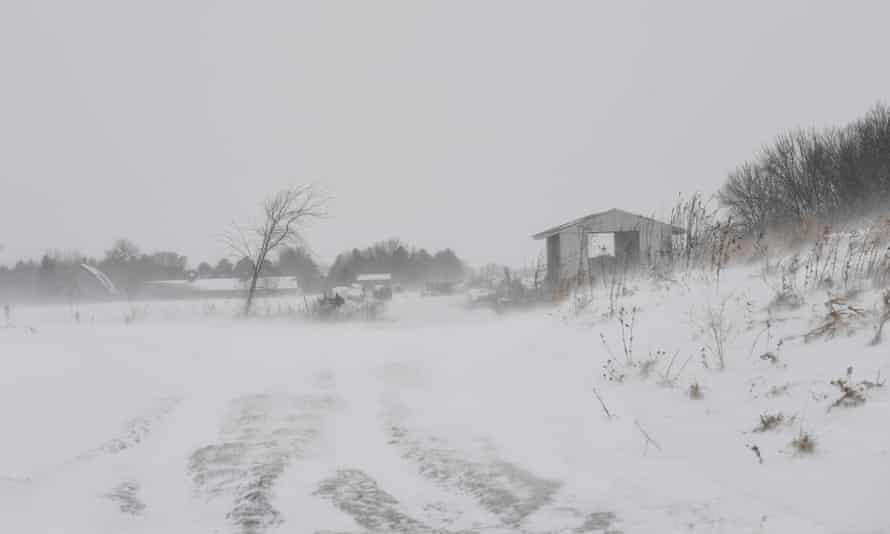
Dr Richard Levins, professor emeritus of applied economics at the University of Minnesota, addressed the event, which served as part elegy for the thousands of small family-owned dairies lost in recent years and part rallying cry for those remaining, despite the odds.
Across the US, dairy farmers have struggled beneath the weight of an industry-wide economic crisis. The cause is the massive overproduction of milk by large dairy operations, which has saturated the market, driving prices down well below the cost of production.
Proponents of mega-dairies cite efficiency and economies of scale, arguing that the model is simply the next logical step in dairying. But opponents, including Levins, say such operations do incalculable damage to the environment and rural communities, and capture bigger slices of a finite milk and cheese market – to the detriment of smaller dairies barely hanging on.
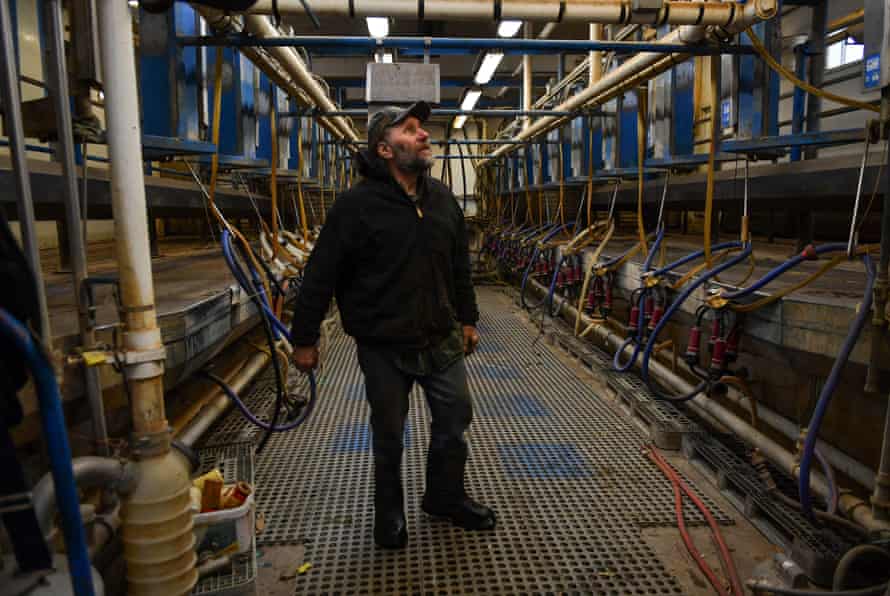
“Unfortunately, the ‘there’s room for everybody’ argument doesn’t work so well in dairy. It’s a matter of simple mathematics,” Levins told the meeting. Bringing in a 5,000-cow dairy doesn’t increase the demand for milk, he said – it simply replaces 50- to 100-cow dairies. “We’re playing musical chairs.”
Rise of a mega-dairy
Dairy conglomerate Riverview LLP is by far the largest mega-dairy operation in the state. At the company’s flagship dairy in Morris, Minnesota, 10,000 cows wait expectantly for the feed truck. In the “nursery”, a still-wet calf, its umbilical cord dangling, struggles against a worker who tilts back the small head and inserts a tube of colostrum all the way to its stomach.
At one day old, calves are strapped into vests, machine-lifted into a truck and transported 10 miles away to the company’s calf facility. A few days later, they are trucked more than 1,000 miles, either to New Mexico (if bound for the beef market) or Arizona (if destined for dairy) – a move that Riverview says is for the warmer weather.
Riverview’s origins lie with the Fehr family, who began a crop and beef farm in 1939. In 1995, seeing an opportunity in dairy, they established their first 800-cow dairy and incorporated as Riverview LLP, a status allowing for multiple owner-investors. One of those investors was the Wulf family, who attended the same church and owned a beef cattle operation. In 2012, Riverview officially merged with Wulf Cattle.
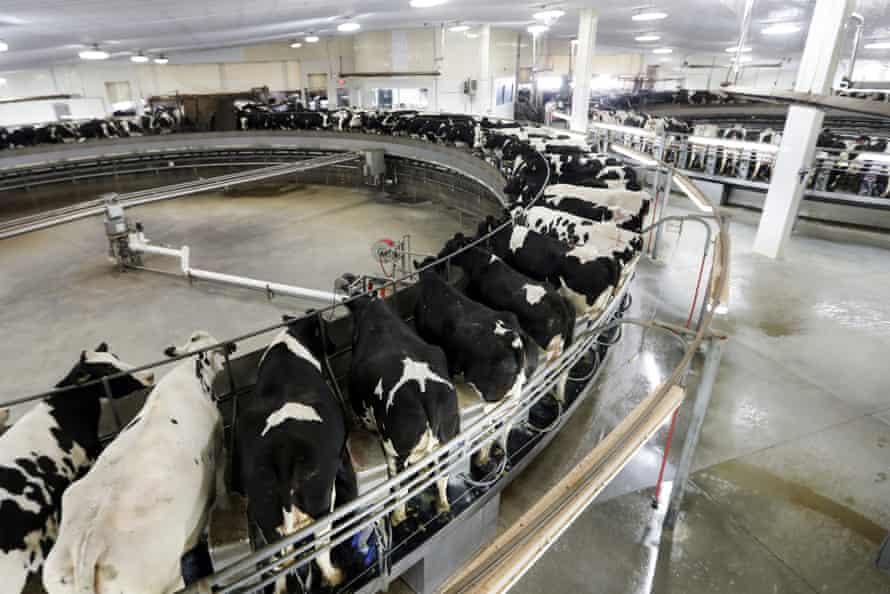
Today, Riverview operates three linked but separate segments – dairy, beef and crop – with at least 25 facilities across five states: Minnesota, South Dakota, Nebraska, New Mexico and Arizona. In Minnesota, the Morris dairy alone produces enough milk every day to fill six 32.5-ton (29.5-tonne) tanker trucks.
“We’re really bullish with the market,” says Natasha Mortenson, who works in community outreach and education for Riverview.
Modern US agriculture is hugely influenced by the vision of Earl Butz, secretary of agriculture under Presidents Nixon and Ford, who championed corporate farming, encouraging farmers to plant “fencerow to fencerow” and “get big or get out”.
Donald Trump’s secretary of agriculture, Sonny Perdue, echoed these sentiments at the 2019 World Dairy Expo in Madison, Wisconsin – a state that lost 10% (more than 800) of its dairy farms that year. “The big get bigger and small go out,” he said. “It’s very difficult on economies of scale with the capital needs and all the environmental regulations, and everything else today, to survive milking 40, 50, 60 or even 100 cows.”
Despite a 55% nationwide decrease in dairy farms between 2002 and 2019, cow numbers have held steady and fluid milk volume has increased – a fact that illustrates a trend toward fewer farms operating on much larger scales.
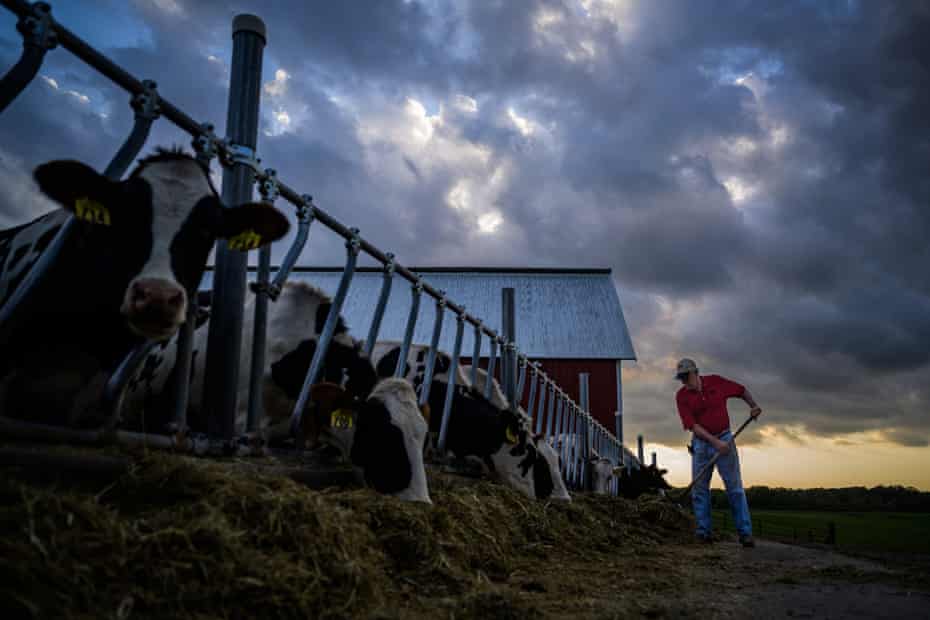
Between 2012 and 2017, Minnesota lost 1,100 dairy farms. In contrast, those years marked enormous growth for Riverview as it built three new Minnesota mega-dairies, a feedlot in South Dakota and expanded its calf and dairy operations to New Mexico and Arizona.
A similar strategy to capture the market was seen in the hog and poultry industries: buy out the smaller farmers at rock-bottom prices, lock in contracts with processors (or acquire your own processing facility), and then seal the doors so no one can get back in when the market rebounds.
Mortenson says Riverview only builds dairies where invited by the community, and, in Minnesota, when cheese processors have an ongoing need for more milk. “We sit at kitchen tables at every single neighbour’s house,” she says. “Does that mean that every single neighbour loves us? No, it does not mean that. But that’s life.”
Unanswered questions
One of those potential neighbours, a crop farmer in Dumont, Minnesota, says a Riverview official visited him in April 2019 and shared a plan to build a 24,000-cow dairy a mile away. The official offered to buy the farmer’s corn for feed, and to sell manure to him as fertiliser. The offer was declined. “I said, I’m not very interested in that because you’re not paying enough for the product, and you’re charging too much for the manure.”
The farmer – who asked to remain anonymous – was also horrified by the idea of so many cows so close to his home. He worried about odour and air quality, wear and tear on the roads, manure leaching into streams and rivers, and the demand on the groundwater supply. “I’m telling you, it’s scary they’re going to come in here and suck that much water from the ground,” he says.
The 24,000-cow dairy has not been built but, according to state records, the company has applied for a permit to build a 10,500-cow dairy approximately 130 miles north in Waukon Township. Additionally, an application for another 10,500-cow dairy, in Grace Township, is under review.
“They never seem to stop,” the farmer says.
The farmer’s concerns echo those of community members in Chokio, Minnesota, who organised a campaign in 2014 against Riverview’s proposed $55m (£39m) Baker dairy, which would have housed 9,000 cows if built.
In August 2014, the Baker dairy proposal came in front of the Minnesota Pollution Control Agency citizens’ board, which, since 1967, had been responsible for reviewing the environmental impacts of industry proposals and determining whether more thorough regulatory impact studies should be required.
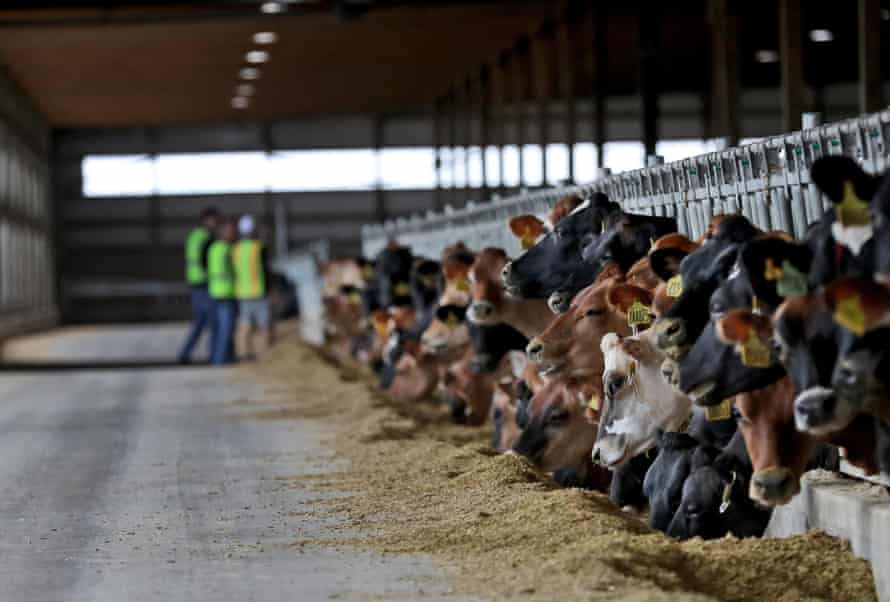
Jim Riddle, who served on the citizens’ board for two years, says there were a number of unanswered questions over the Baker dairy proposal.
“The owners of the facility did not have access to sufficient land to spread even half of the manure that would be generated,” wrote Riddle. “They did not have data on how their proposed massive water drawdown would impact existing crop and livestock farms in the area. They did not have an agricultural mitigation plan in place for their proposed 12-mile pipeline to carry water from a well that had been permitted seven years earlier for an unbuilt ethanol plant, to the Cafo [confined animal feeding operation].”
The only way to resolve those questions was by compiling a full environmental impact statement (EIS), said Riddle – and the board voted unanimously to require one. After the board ordered the statement, Riverview retracted its proposal, and Baker dairy was never built. But there were enormous consequences for the citizens’ board.
As reported in the Star Tribune, Riverview’s Brad Fehr “said the ruling prompted him to spend two weeks airing his concerns with groups like the Minnesota Milk Producers Association, Minnesota AgriGrowth Council, Minnesota Farm Bureau and the State Cattlemen’s Association”. In turn, Riddle says, corporate agricultural interests – led by the AgriGrowth Council, which presented Riverview LLP with a distinguished service award in 2012 – acted swiftly, putting pressure on state legislators to eliminate the citizens’ board.
The citizens’ board was abolishedin June 2015. “So that told me that Riverview has tremendous political influence over both parties,” says Riddle.
Wulf says that while the denial of the Baker permit was the catalyst for the scrapping of the board, Riverview was “not involved in that pressure or in that process”.
‘We need family. We need community’
Jim Van Der Pol, 73, grew up on the family farm in Kerkhoven, Minnesota, and returned in the 1970s with his wife, LeeAnn. They raised their children there and began their own small farm business, which sells grass-fed beef and pork to restaurants and customers throughout the state.
The Van Der Pols used to be surrounded by working family farms, but that has changed. “I sometimes think the right way to say it is that there are ghosts in the land,” says Jim. “It’s a lot lonelier than it was.”
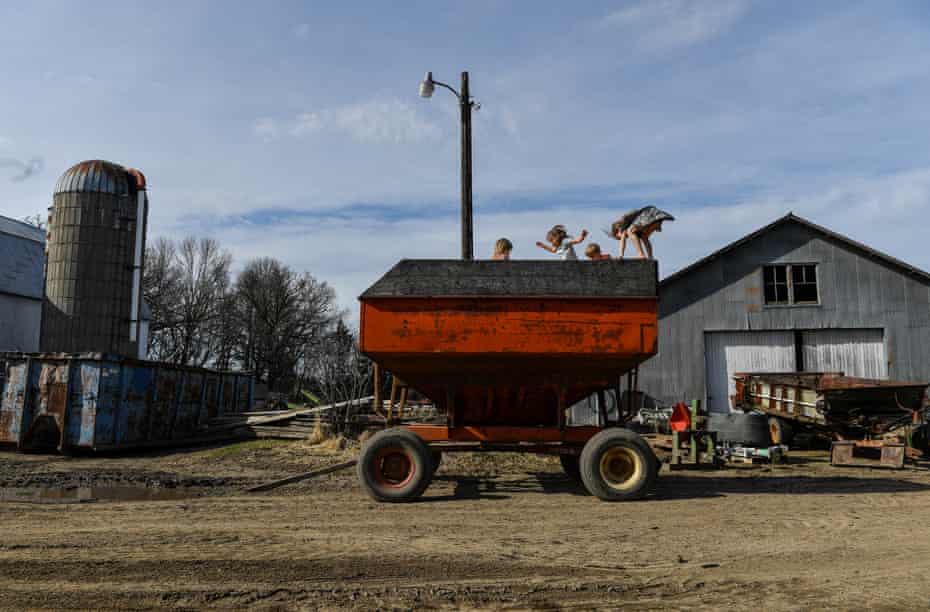
Yet there are five Riverview operations within 10 miles of the Van Der Pols’ house and another within 15 miles. Approximately two miles away is Riverview’s Louriston dairy, home to nearly 10,000 cows, which the Star Tribune reports“drink enough water to drain an Olympic-sized swimming pool in just over two days, and produce enough manure to fill one every three days”.
Communities change when mega-dairies flourish, says Levins, “[decreasing] the economic activity on Main Street. And of course, it decreases the number of people that go to church, go to school, go to the hospital, that sort of thing. So the consolidation in the dairy leads to consolidation in all of those services as well.”
Over supper, the Van Der Pols discuss the tangible and intangible costs of Riverview moving in: the loss of community, unknown environmental ramifications, even a noticeable change to the night sky due to the 24/7 lights from the facilities.
“In the wintertime here, especially when it’s still or quiet, [the stars] are so bright at night … I mean, it just goes on for ever,” says Jim. “But now Riverview is starting to interfere with that, because that place is lit up like a Christmas tree.”
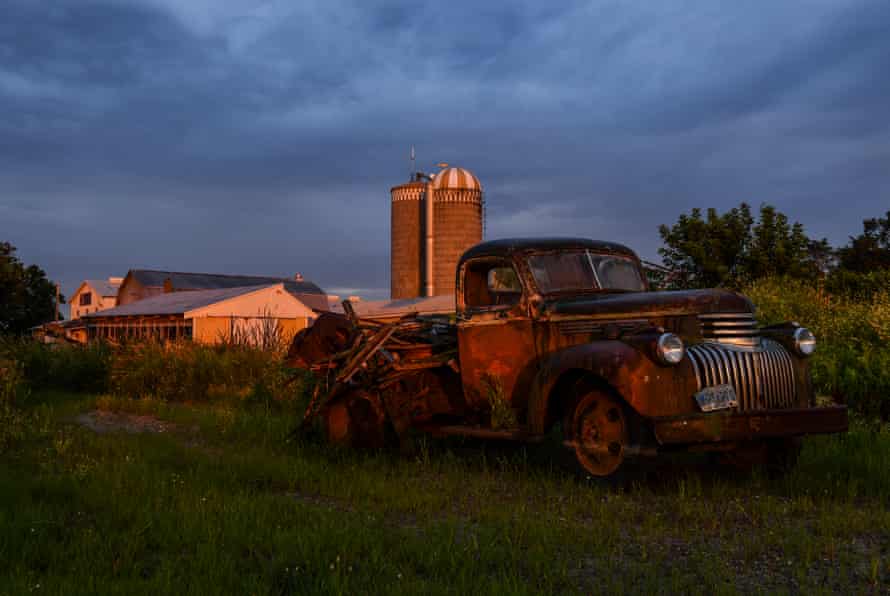
Back at the pub in Greenwald, dairy farmer James Kanne addressed the room. “I’m a survivor,” he said – the last of the dairies from his childhood still in business, but only with help. Recently, his daughter and son-in-law came back to the farm.
“And that is what we need. We need family. We need community.”
Heads nodded across the packed room.
The story of the mega-dairy is not about “little dairies becoming a little bit bigger”, says Levins. “It’s about enormous operations coming in and putting everyone else out of business by the fact that there’s only so much business to go around. People say, ‘we can have both’. Well, if there’s only a certain amount of dairy demand, in a way, you can’t.”
He pauses. “You can have one or the other.”
Source: The Guardian











